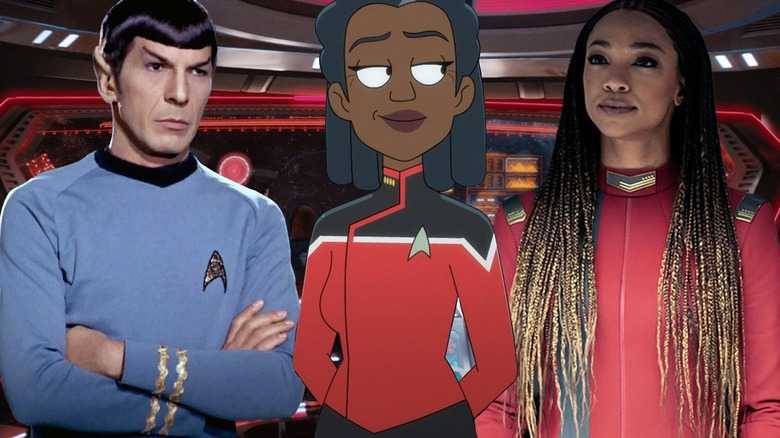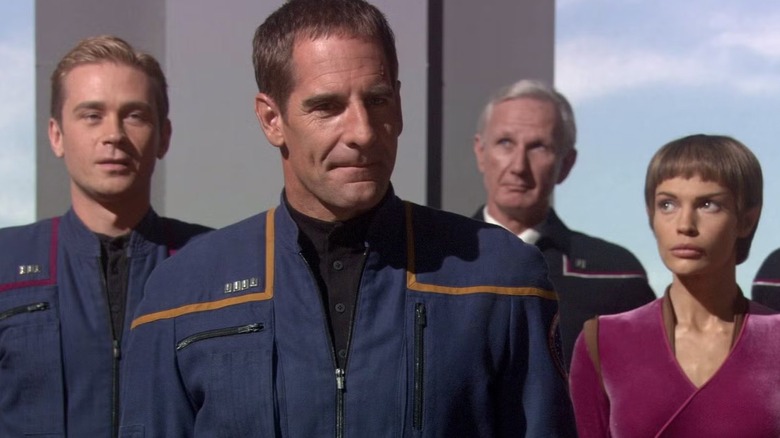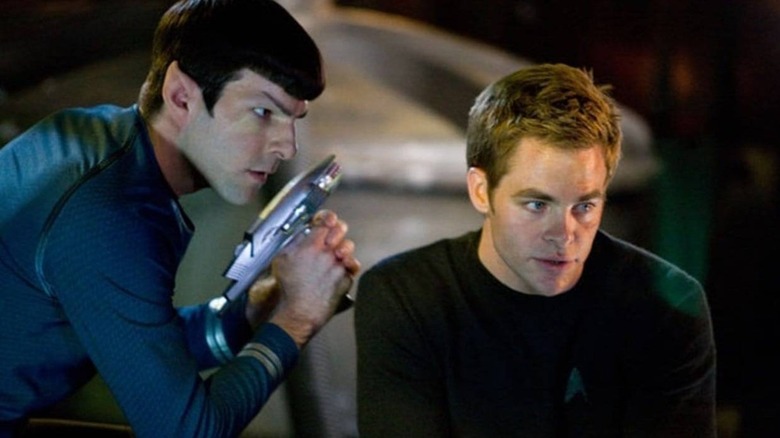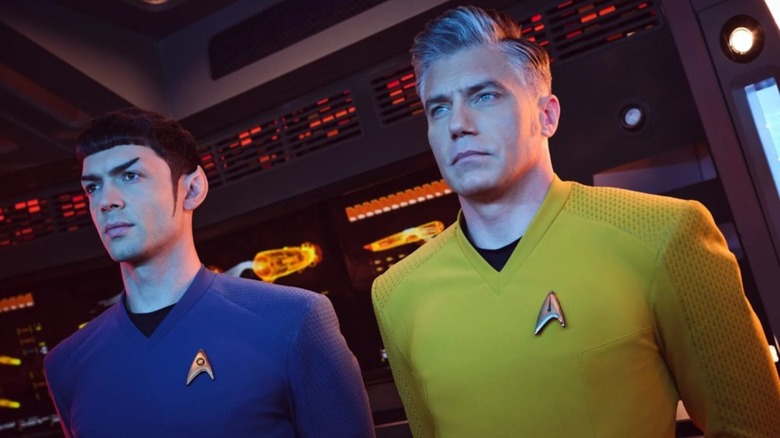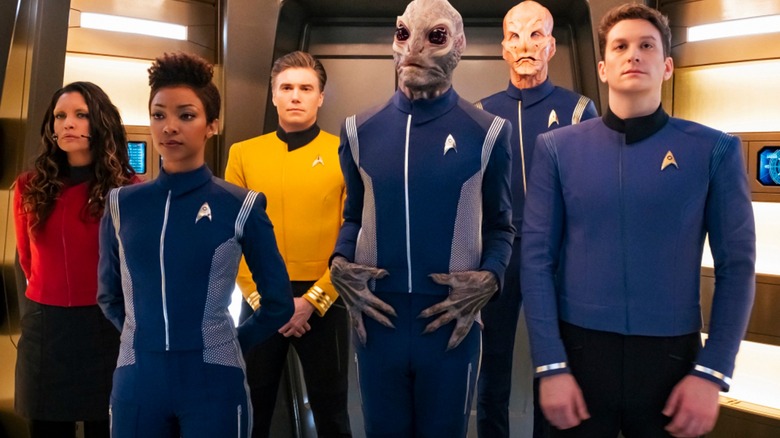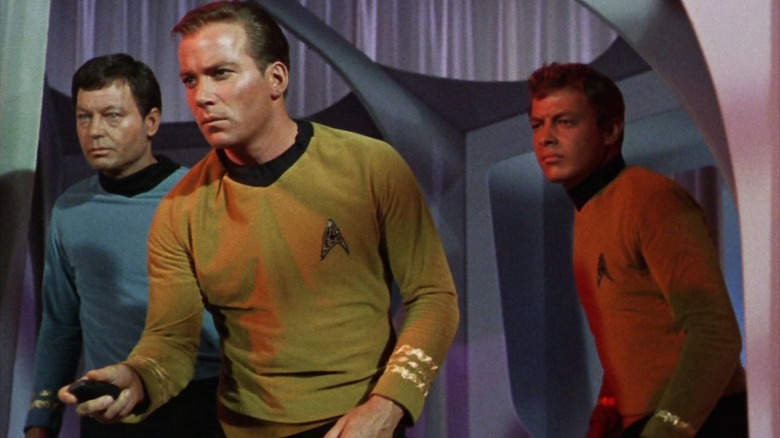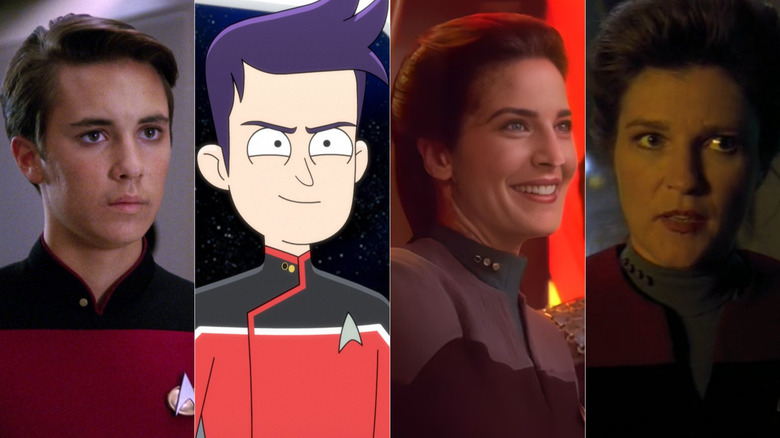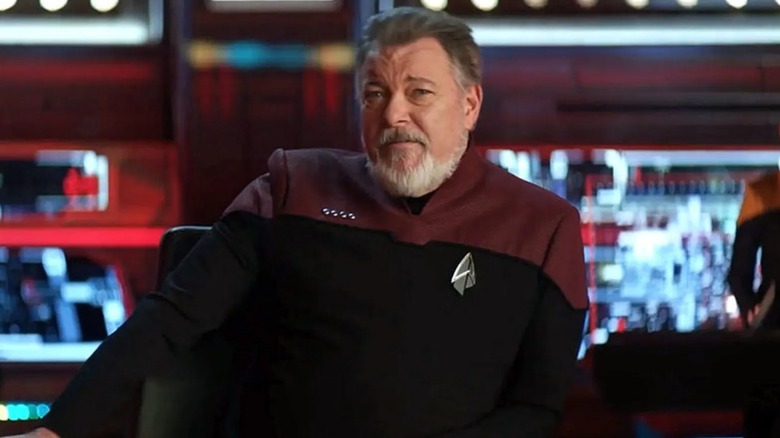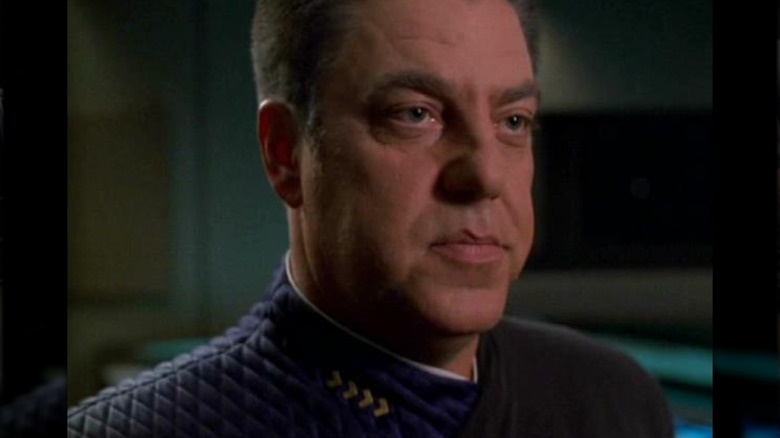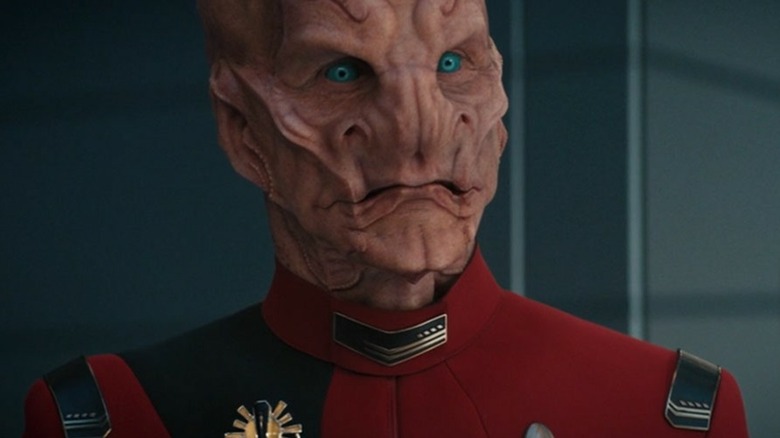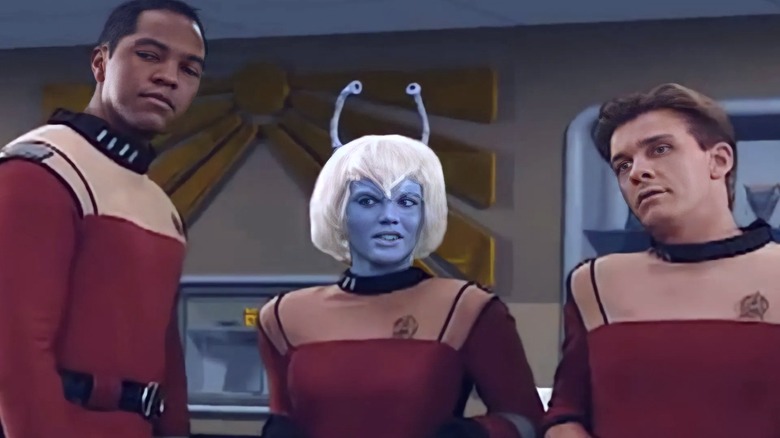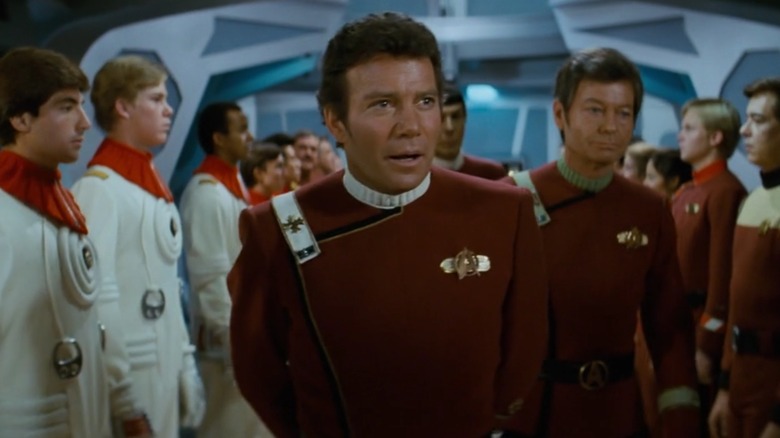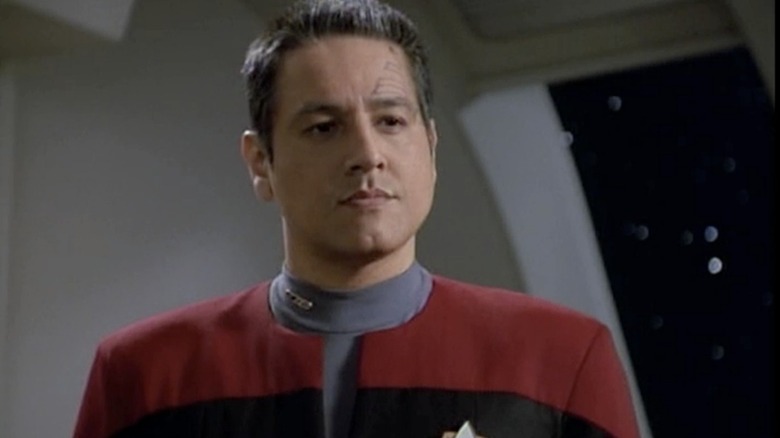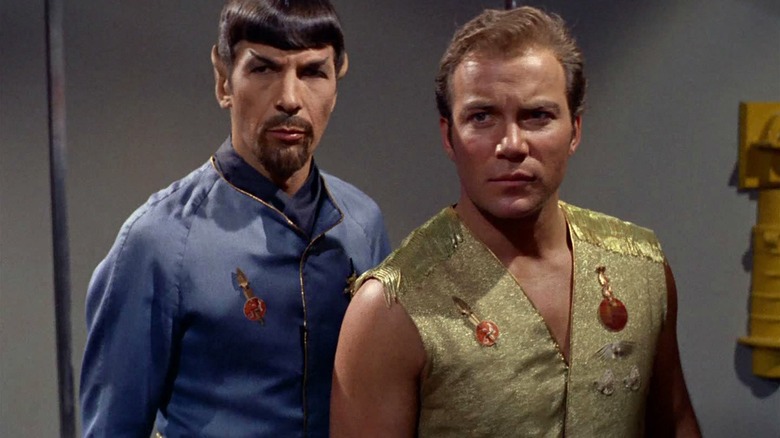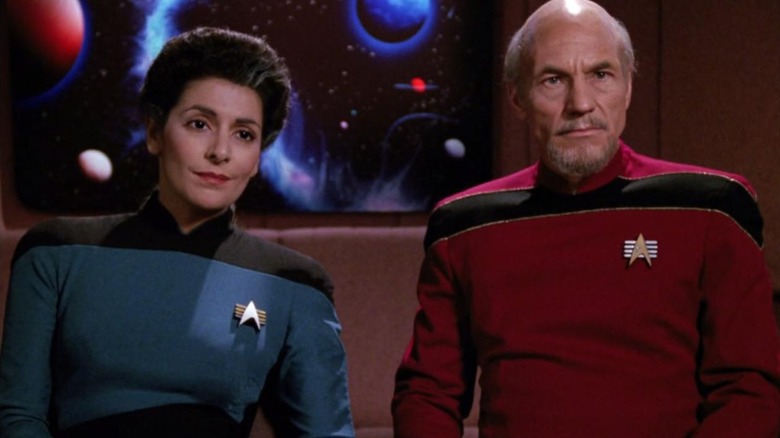Star Trek's Starfleet Ranks Explained
When Gene Roddenberry created "Star Trek," he didn't pull it out of a vacuum. Impressed with a real life World War II Navy vessel, the USS Enterprise, Roddenberry modeled the capital ship of Starfleet after the carrier and the organization itself after the Navy. For this reason, many of the ranks and designations worn by Starfleet personnel have roots in the real world.
That's why a helmsman pilots the USS Enterprise from the bridge. There's also a galley and a brig. What's a bit murky are the rank insignia meanings themselves. This isn't Roddenberry's mistake, but rather due to the long history of the franchise. Like any military or civil service, rank insignia and uniforms change over time.
This is a common practice, and the ranks of the U.S. Navy look different today than they did in decades and centuries past. "Star Trek" is no different, so whether you grew up watching "Star Trek: The Original Series" (with all of its timeline complications) or "Discovery," your knowledge of Starfleet ranks likely differs from others. Here's how "Star Trek'" breaks out their ranks chronologically, from "Enterprise" to "Strange New Worlds."
Starfleet's first use of rank insignia in the mid-22nd century
Starfleet was founded in the 2130s as an Earth-based space exploration organization. By the 2150s, a new class of starship, the NX-class, was created that allowed for wider exploration. The Enterprise NX-01 was captained by Jonathan Archer (Scott Bakula) and set off in 2151 on a mission that would ultimately lead to the Coalition of Planets in 2155.
That organization would then become the United Federation of Planets in 2161. The NX-01 was an important ship in Starfleet's history, and, while not a military vessel, the Enterprise had a crew that all wore specific rank pips and blue jumpsuit-style uniforms, with a colored band denoting their division. There were three enlisted ranks: Crewman 3rd Class, Crewman 2nd Class, and Crewman 1st Class.
These were represented by the Starfleet delta in the center of a circle with a stripe pointing diagonally up on the left. Crewman 3rd Class had one stripe, 2nd Class, two, and 1st Class, three. Officer ranks were represented by small silver pips. An Ensign had one, a Lieutenant had two, a Commander had three, and Captain Archer wore four.
The Starfleet rank insignia of the early 23rd century
By the 2230s, the (also complicated) Kelvin timeline saw Starfleet abandoning the practice of pinning pips onto people's uniforms, instead relying on stripes for its ranks. These are seen in the 2009 film "Star Trek." There are several deviations during this time period that suggest some ships had different standards and practices regarding uniforms.
Gene Roddenberry modeled Starfleet's rank insignia off U.S. Navy ranks, which included sleeve stripes for officers. The film followed this model, though it only had three ranks: Lieutenant Junior Grade, Lieutenant, and Captain. A Lt. j.g. wore only a single thick stripe, while a Lt. wore the same as their bottom stripe, with a thinner stripe above it.
Captains wore three stripes, which featured two wide ones separated by a thinner one in the middle. The 2009 film uniforms differ from the original series, where these stripes were shown in either gold or silver with other small differences. Despite being the same characters, it's another timeline deviation following the destruction of the USS Kelvin.
Starfleet's ever-evolving rank insignia of the mid-23rd century
The franchise expanded with two series set around the time of "The Original Series," which introduced several new rank insignia, Starfleet deltas, and uniforms. These were close to what was seen in the 1960s-era series, but again deviated. In "Strange New Worlds," pips were reintroduced as small raised or indented dots on the delta.
Additionally, the deltas were gold for command, bronze for operations, and silver for sciences and medicine. They also featured a different icon in the center-top, depending on the different departments. The ranks seen in "Discovery" and "Star Trek: Strange New Worlds" include Ensign, Lieutenant Junior Grade, Lieutenant, Lieutenant Commander, Commander, and Captain.
In terms of pips, an Ensign wore one, while a Lt. j.g. had one raised and one indented. Lt. deltas had two, and Lt. Cdrs had two raised and two indented, while Commanders' deltas had three pips and Captains had four. These were first seen in 2239. The insignia within the deltas come straight from "The Original Series," where they were patches sewn onto uniforms instead.
The 2250s rank insignia shakeup
Things changed in the 2250s, when the USS Discovery returned to the use of sleeve stripes. This series evolved the uniforms and ranks as it progressed. This was largely due to a massive time-jump, but also due to the changes in Starfleet throughout "Discovery." This included a surprise return to the colorful uniforms of "The Original Series" by the fourth season.
Enlisted personnel wore a uniform reminiscent of those worn on Captain Archer's NX-01 Enterprise. Officers wore a traditional tunic-style colored uniform top and black pants, or a skirt and leggings. While Ensigns served during this time, they had no rank of their own. Lieutenant Junior Grade, Lieutenant, Lieutenant Commander, and Captain certainly did. The Lt. j.g. sleeve stripes featured only one band.
A Lt. wore the same with a thinner stripe just above the first. A Lt. Cdr. wore two thick stripes, and the Captain wore two thick stripes separated by a thinner one. That's similar to what's shown in "The Original Series" and "The Animated Series." Additionally, three colors were used: blue with a silver stripe for sciences, red on red for operations, and gold on yellow for command.
The reduced usage of rank insignia during the late 23rd century
By the time the USS Enterprise NCC-1701 set out on its five-year mission with Captain Kirk (William Shatner, featuring his beloved over-the-top performance) in command, Starfleet had changed its ranks once more. By 2266, the majority of enlisted personnel wore a jumpsuit-style uniform reminiscent of those worn when Starfleet was founded, with no rank displayed. This also included Chief Petty Officers and Ensigns.
The officers above Ensigns wore tunic-style colored uniform tops and black pants, and sleeve stripes were used to denote rank. Instead of a solid band, the stripes were modified to include a wrapped stripe as well as a broken one, making it a bit easier to identify a Starfleet officer's rank at a glance.
A Lieutenant Junior Grade was the first rank to display a stripe, which was slashed. Lieutenants also wore a single stripe, though it was solid and wrapped. Lieutenant Commanders wore two stripes, where the bottom was solid and the one above was slashed. Commanders wore two solid stripes, while Captains continued the trend of two solid lines separated by a thinner, slashed one.
The 24th century simplified things
It took 18 years after the cancellation of "The Original Series," but in 1987, "Star Trek: The Next Generation" introduced an all-new USS Enterprise captained by Jean-Luc Picard (Patrick Stewart). With the new ship came fresh uniforms, including rank insignia, and delta. This insignia also functioned as a communications badge.
During this period, which began in 2355, uniforms were more streamlined, and rank was denoted by small, circular pips on the right side of the collar. For Captain and below, only four pips were used. A Chief Petty Officer wore one black pip and an Ensign wore one gold pip. Lieutenant Junior Grade included one gold and one black pip, and a Lieutenant's rank included two gold pips.
Lieutenant Commanders wore two gold and one black pip, and a Commander wore three gold, while Captains wore four gold pips. In the 2370s, the Chief Petty Officer rank included three chevrons and two pips on an epaulet. This era included "The Next Generation," "Deep Space Nine," "Voyager," and "Lower Decks." Pips dominate how we imagine Starfleet uniforms with their constant representation.
The 25th century saw minor modifications to pips
While several television series and films explored the "Next Generation" era of "Star Trek," it didn't end with "Lower Decks." "Star Trek: Picard" picks up the story of the erstwhile captain of the Enterprise-D and E. "Picard" reveals Jean-Luc's (Patrick Stewart) life in retirement, revealing him as a retired Admiral who's been out of action (and Starfleet) for years. It's another turn in Picard's long and often confusing personal timeline.
When Picard reenters the galaxy's affairs, he runs afoul of Starfleet, which has once more changed officer rank displays. Uniforms also received an upgrade, as did the delta, and much more. The first time the new rank insignia is shown is when Picard meets with Fleet Admiral Clancy (Ann Magnuson) in her office at Starfleet headquarters on Earth.
Pips are still used and they denote the same ranks as earlier. There were two significant changes: color and placement. Instead of locating the pips on the collar, they were moved to the right breast, and gold was abandoned for silver. It's unclear when this change was made, but by the early 25th century, the pips were back on the collar.
Only a few ranks were shown in the 29th century
"Star Trek: Voyager" is all about exploring the unknown reaches of the galaxy, and, like other series in the franchise, it also explores time. Granted, this was accidental, and Captain Janeway (Kate Mulgrew) wasn't a fan of temporal events. Still, she and her crew mucked up the timeline on occasion, adding two episodes to our collection of best time travel stories in all of "Star Trek."
In the episode "Future's End," the USS Voyager comes into contact with Captain Braxton (Allan G. Royal) from the 29th century. They wind up trapped in 20th-century Los Angeles before fixing the timeline and returning to the Delta Quadrant. In "Relativity," the audience gets more than a passing glimpse of the 29th century, when the Federation timeship USS Relativity is introduced.
This shows a completely revamped rank insignia, delta, and uniform. In this episode, Captain Braxton (now older and played by Bruce McGill, pictured) has four right-facing bronze chevrons representing his rank. Other officers fill out the ranks a bit, showing that an Ensign has a single chevron and a Lieutenant has two. From this, it's probable that a Commander wears three chevrons, but none are visible in the episode.
The 32nd century featured considerably different rank insignia
"Star Trek: Discovery" may have started in the 23rd century prior to the events of "The Original Series," but it didn't conclude there. Yes, it's more messy timeline action, and it's the focal point of "Discovery's" story. The USS Discovery ultimately found itself in the 32nd century, where Starfleet was a shadow of its former self and the galaxy was reeling from a cataclysmic event.
The Discovery eventually met up with what remained of Starfleet, and the series showed how Discovery and its crew were able to put things right. Since "Discovery" takes the franchise a few centuries beyond any seen previously, everything was updated, including rank, uniforms, and deltas. The rank shown in 3189 was once more integrated in the tricom badge, as well as on epaulets and around the neck.
Crewmen wore a badge without rank sign, while Ensigns had a single gold pip on the right. Lieutenant Junior Grade was denoted with two pips, one gold and the other black, while Lieutenants had two gold pips. Lieutenant Commanders wore two gold and one black pip, and Commanders wore three gold pips. Captains wore four, and all ranks also appeared as golden pips on the shoulder and neck.
Starfleet Academy Cadets also have rank insignia
Starfleet Academy, located in San Francisco, is a school where every prospective officer must attend to be commissioned as an Ensign. Everyone, from Captain Pike (Anson Mount) to Captain Burnham (Sonequa Martin-Green), attended the school. Just like a military academy in the real world, Cadets wore rank insignia designating their year in school.
In their freshman year, students were called Cadet 4th Class. This continued into 3rd Class, 2nd Class, and finally, Cadet 1st Class for seniors at Starfleet Academy. The rank insignia changed a bit throughout the franchise, with only two in the late 2250s. Cadets 1st Class wore a bronze or gold delta centered in a rectangle with four horizontal bars.
This remained the only worn rank until the 2360s, when Starfleet adopted a new system of pips similar to those worn by commissioned officers. These were black (sometimes silver) rectangles, beginning with one for Cadets 4th Class. Next, two pips denoted 3rd Class, three for 2nd Class, and four pips for 1st Class. The "Star Trek: Starfleet Academy" series currently in the works looks to be set in the 32nd century, but of writing, their rank and uniform style is unclear.
Starfleet uses enlisted rank insignia minimally
It's fair to say that pretty much every "Star Trek" movie and TV series focuses on Starfleet's officers, but they're not the only ones onboard a starship. Most of the crew is made up of enlisted personnel, mirroring the practice of modern warships. For example, the real Navy vessel USS Gerald R. Ford (CVN-78) has a complement of over 4,500 personnel, around 500 of whom are officers.
That's around 11%, which is probably higher than a Starfleet vessel's complement of officers. Regardless, enlisted personnel serve in Starfleet. Throughout the franchise's history, enlisted ranks have been used sparingly, and in most series and films, they don't wear any rank. Starfleet's non-commissioned officer ranks include Petty Officer Second Class, Petty Officer First Class, Chief Petty Officer, Senior Chief Petty Officer, and Master Chief Petty Officer.
These were most used during the late 2270s to the 2350s and were represented by a silver octagon. Chief Petty Officers' octagons featured a golden trapezoid on top, while Senior Chief Petty Officers' included a golden staff. For Master Chief Petty Officers, the staff was replaced with a diamond. In some instances, Petty Officers were referred to as Yeoman, and Warrant Officers also served, but they lacked a standardized rank insignia.
Starfleet's provisional rank insignia
While Starfleet had specific rank insignia for its officers, it also employed people who were given provisional rank insignia. These were worn by those who served aboard a starship in a special capacity, and were first introduced in "Star Trek: The Next Generation." The rank insignia were fleshed out for "Star Trek: Voyager" to integrate the Maquis crew with Voyager's Starfleet personnel.
This was during the pip era, but provisional ranks were dissimilar, set within a golden lozenge worn in the same place on the collar as Starfleet pips. These recognized Crewmen, Ensigns, Lieutenant Junior Grades, Lieutenants, and Commanders. A provisional rank for Captains was initially designed, but it wasn't used in "Voyager" or any other series.
The provisional rank for a Crewman features a black bar in the center. For an Ensign, the bar is a light golden color matching the outline of the lozenge. Lt. j.g. rank includes a black bar next to a light-golden one, while Lieutenants wore two light golden stripes separated by a thin gap. Commanders like Chakotay (Robert Beltran, pictured) wore a black stripe beside two light-golden ones separated by a thin gap.
The Mirror Universe had its own rank insignia
If there's one thing "Star Trek" fans know, it's that anyone with a goatee is an evil counterpart from the Mirror Universe ... at least for Spock (Leonard Nimoy). The Mirror Universe has been explored in many "Star Trek" series, and exists parallel to the prime reality of the franchise. There, Earth's spacefaring organization is called Imperial Starfleet.
It's governed by the Terran Empire, which rules the galaxy as a tyrannical dictatorship. It's entirely antithetical to what "Star Trek" represents, which is why it's called the "Mirror Universe." Despite not being in Starfleet, the Terran Empire of the Mirror Universe has rank insignia, which are similar in title but different in design. Still, the same ranks are represented, from Ensign to Captain, as well as Chiefs and Crewmen.
Most ranks were shown as shoulder epaulets with stripes denoting a person's rank, but like the prime universe, these changed over time. Wrapped golden stripes were used at one point, as were enlisted ranks of the Military Assault Command Operation, the infantry of the Terran Empire. While the uniforms, rank, and occasional facial hair were dead giveaways, there were still many similarities between the two universes, which interacted on numerous occasions.
Alternate Universe Starfleet ranks differed slightly from the Prime Universe
Thanks to occasional time travel shenanigans, "Star Trek" explored multiple alternate universes. In these, minor deviations to uniforms and rank insignia indicated how Starfleet was different. The "Kelvin Timeline" introduced in the 2009 film "Star Trek" featured those minor changes mentioned above, while a quantum fissure met by the Enterprise-D in the "Next Generation" episode "Future Imperfect" also introduced multiple changes.
Instead of wearing pips on their collars, these alternate Starfleet ranks were denoted on their delta comm badges. These were represented by black, silver, and gold horizontal bars (pictured). A Crewman had four black bars, while an Ensign wore a single gold bar atop three black. Lieutenants balanced two gold bars above two black, while Lieutenant Commanders wore two gold bars atop a single silver over a black bar.
Commanders wore three gold bars on top of a single black bar, while Captains had four gold bars. Only one Admiral rank was shown, which features four silver bars and a four-pointed star set within a golden delta. Alternate universes aren't as common as Mirror Universe encounters, but they do pop up every once in a while, so more rank insignia may be introduced in future entries in the "Star Trek" franchise. All in all, it's a lot to take in, but it's a trove of fun detail, too.
